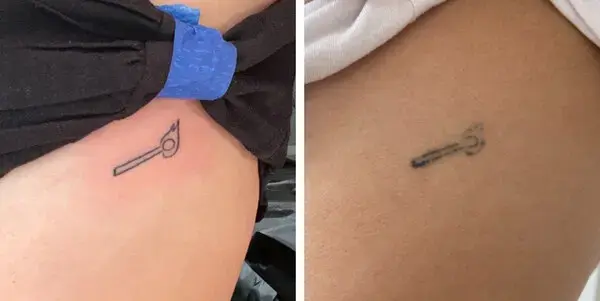Do Ephemeral Tattoos Truly Fade Away Completely Over Time?
- Taylor Paton
- Aug 14
- 4 min read
In the past few years, ephemeral tattoos have captured the attention of many seeking a temporary twist on body art. Designed to fade over time, these tattoos provide a temporary expression of self, making them appealing for those who prefer variety without the long-term commitment. But the key question remains: do these tattoos really disappear completely? In this post, we will dive into the info behind ephemeral tattoos, how they are applied, and what you can realistically expect if you choose to get one.
What Are Ephemeral Tattoos?
Ephemeral tattoos are created using specialized inks that are made to break down and fade away. Unlike traditional tattoos, which are permanent and can require painful laser removal, ephemeral tattoos offer a more adaptable option for people who want to change their body art regularly. Or get somewhat of a temporary tattoo with less commitment.
Typically, these tattoos can last from 6 months to around 3 years. Some recipients of ephemeral tattoos may end up having small permanent markings, while majority of the tattoo is faded. The duration varies based on several factors, including the type of ink used, the tattoo’s location on the body, and individual skin characteristics.
The Science Behind Ephemeral Inks
The inks in ephemeral tattoos are designed with biodegradable materials that are less stable than those in traditional tattoos. This means they gradually absorb into the body, resulting in a slow fading process.
Common ingredients include natural pigments and organic compounds, which tend to be less harsh than synthetic inks. For instance, inks made from plant-based dyes can be a safer option, minimizing the risk of allergic reactions. However, the exact formulas can differ significantly across brands and artists.
Factors Influencing Fading
Multiple factors can affect how quickly an ephemeral tattoo fades. Here are some important ones to consider:
Skin Type
Your skin type plays a major role in how well the ink adheres and fades. For example, people with oily skin may notice their tattoos fading faster—sometimes within just a few months—while those with dry skin might see their tattoos last longer, potentially up to two years.
Location on the Body
Where you place the tattoo influences its lifespan significantly. Areas that experience more friction, like the hands and feet, often see faster fading. In contrast, tattoos on more stable areas, such as the upper arms and back, may last longer. For instance, a tattoo on your wrist might last around 6 months, while one on your back could remain visible for over a year.
Aftercare
The care you give your tattoo after getting it can prolong its appearance. Keeping the area clean and moisturized can help the tattoo last longer. Neglecting aftercare could lead to premature fading. For example, healing agents like aloe vera can keep the skin hydrated and shield the tattoo as it fades.
Do They Fade Completely?
Although ephemeral tattoos are designed to fade away, the degree to which they do can vary widely. Many individuals report that their tattoos fade significantly, often to the point of being nearly invisible. However, some residual ink may still remain—especially if the tattoo was applied more heavily or if the colors used were particularly vibrant.
Expectations should be managed when it comes to these tattoos. While they are temporary, complete fading is not guaranteed. Many people find themselves with light shadows of their tattoos lingering even after the expected fading timeframe.
The Benefits of Ephemeral Tattoos
Ephemeral tattoos come with several advantages, making them an attractive choice for many:
Flexibility
The most significant benefit is definitely the flexibility they offer. If you are unsure about a design or simply want to try something new, an ephemeral tattoo allows you to experiment without settling for a permanent commitment.
Less Painful
For many, the process of getting an ephemeral tattoo is less painful than a traditional tattoo. The inks are often applied in a way that requires less deep penetration, making for a more comfortable experience.
Eco-Friendly Options
With increasing awareness of environmental issues, many ephemeral ink brands are creating products from biodegradable materials, offering a more sustainable alternative to conventional inks.
The Drawbacks of Ephemeral Tattoos
While there are numerous benefits, there are also some limitations to consider:
Longevity
For those who want a permanent tattoo, the temporary nature of ephemeral tattoos can be a drawback. If you fall in love with a design, it may leave you wanting to get it permanently inked.
Variability
The fading process can be unpredictable. Some tattoos may fade differently than anticipated, with some disappearing too quickly and others lingering longer than desired.
Limited Design Options
Not all designs work seamlessly with ephemeral inks. Intricate or highly detailed designs may not translate as well, possibly limiting your choices. Would not be ideal for larger meaningful pieces.
Final Thoughts
Ephemeral tattoos present an interesting alternative to traditional body art, allowing temporary means of self-expression without the same long-lasting effects as a traditional tattoo. While they aim to fade completely, individual experiences depend on skin type, tattoo placement, and aftercare.






Comments